COMPLETE EPISODE GUIDE WITH CRITICAL COMMENTARY
Season 4 (1963)
by Andrew Ramage
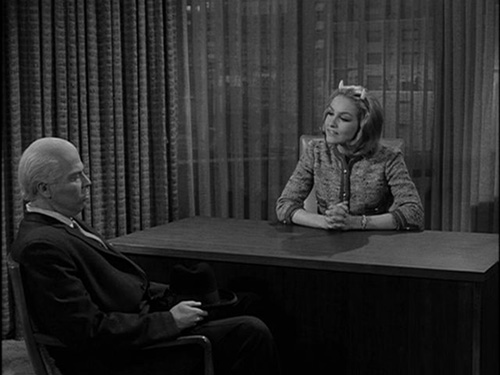
SEARCH THIS GUIDE BY SEASON: Season 1 (1959-1960) ; Season 2 (1960-1961) ; Season 3 (1961-1962) ; Season 4 (1963) ; Season 5 (1963-1964)
Rating Guide:
I - Superior; II - Excellent; III - Very Good; IV - Fair;
V - Below Average; VI - Not Good.
SEASON 5 ARTICLE
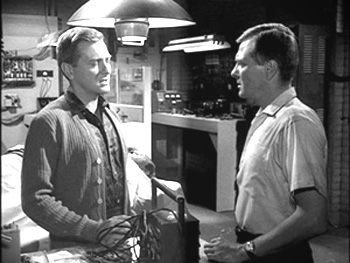
ORIGINALLY BROADCAST AS EPISODE 103
STARRING CAST: George Grizzard, Gail Kobe, Katherine Squire
WRITER: Charles Beaumont
DIRECTOR: Perry Lafferty
SUMMARY: Alan Talbot meets and falls in love with Jessica Connelly, and they take a trip to his hometown in Coeurville, New York. But when they arrive, none of his relatives are there and he finds out that the university he works for no longer exists somehow. It is then that he begins to learn his true identity...
RATING: I
The first of the hour episodes was perhaps the best, if not the classiest, of the eighteen segments, and it came from the pen of none other than Charles Beaumont. Based on his own short story, it was to be one of his last teleplays for Twilight Zone. An artificial man breaks out of the laboratory where he was built, and into society. This was no robot - it was a man made with a past, a present, and human emotions. We never get to know what the robot is made of. It could be iron or copper or even tungsten, the material in tungsten wedding bands. But his creator made a few slips in the process of developing his brain and instead of being guided by a conscience, he has no inhibitions and is a murderer. After falling in love and becoming engaged within a matter of a few days, with his violent tendencies barely kept under control, he returns to re-meet his creator, whom he nearly killed on the day of his birth.
"In His Image" required an actor who could convincingly play the inventor and the robot made in his image when they come to a head-to-head confrontation. George Grizzard, who had been marooned in a stereotypical fairytale three years earlier in "The Chaser", plays Alan Talbot and his creator, Walter Ryder. His portrayals are so flawless that it is almost as if the two men are being played by two different actors. Their 'reunion' in the affluent home and laboratory of Ryder is rendered in true "Twilight Zone" fashion; the questions that beckoned from the beginning are answered one by one, with an appropriate amount of reservation. Like Serling's "The After Hours", the plot focuses on building up to an extremely high level of tension, but Beaumont went this a few steps better. The tension remains as Walter tells Alan that he is a mechanical device that will someday break down and won't age...Alan stages a protest and is sure it's all a lie. Once he realizes it is true, another violent physical fight ensues. Again, Walter Ryder narrowly escapes. Acting as the double (for the scenes where both men are in the same room together) was Joseph Sargent when Grizzard was photographed from the front. The scenes where Alan and Walter are standing together in Walter's living room were shot separately, on two different sets.
The story has an odd beginning, where a man (Talbot) enters a subway platform and is met by an elderly bag lady-slash-religious fanatic...the kind of God-fearing, pamphlet-pushing, wrinkled wood nymph to be found on public transportation anywhere, who is determined to make sure everyone else is following God's agenda. Grizzard and Katherine Squire, with her gravelly drone, handbag, and shawl, got the episode - and the Fourth Season of "Twilight Zone"- off to a thunderous start:
LADY: Are you sick, young man?
ALAN: No.
LADY: You look sick. My husband looked like that, just before he died. All white and pasty.
ALAN: No, I'm alright.
LADY: Just what he said. Just those words. 'I'm alright.' Went to bed. Next morning, I went to wake him up and there he was, sprawled out dead. You don't drink, do ya?
ALAN: What?
LADY: That's what killed my Jack. I told him it was The Devil's work, but he wouldn't listen to me. You can see where he is now. Oh, The Devil's all around us, Mister, all around us, everywhere we go. And if we don't fight him, if we don't stand up to him, we'll suffer eternal torment!
ALAN: I'm sure you're right, yes.
LADY: I know I'm right. And I'll tell you how I know.... It was on a Sunday. I was ironing if you please. And that's when it came, out of a clear blue sky! Oh, the Good Lord's own sweet breath, and his voice like an electric shock! I was revelated! Oh, praise Him, Mister and praise His good works! Do you read the book?
ALAN: What book is that?
LADY: Why, the Good Book!
ALAN: Oh yes, all the time.
LADY: You sure you're tellin' the truth now? We may be a mile underground, Mister, but he hears every word.
ALAN: Yes, it's the truth!
LADY: Alright! Leviticus, Chapter Five, Verse Two!
MAN'S VOICE: (o.s.) You're perfect! You're perfect!
LADY: Well?!
ALAN: Lady, please!!
LADY: (reciting) If a soul touch any unclean thing, whether it be a carcass of an unclean beast, or a carcass of unclean cattle, or the carcass of unclean creeping things, and IF it be hidden from him, HE SHALL ALSO BE UNCLEAN, and GUILTY!
ALAN: Lady, please go away!
LADY: Don't you wanna be saved?!
ALAN: NO! I just want to be left alone!
LADY: We're never alone! Don't you know that? He's with us all the time and He'll help us if we only let Him. But we've got to be be saved first! (she shoves a pamphlet at him that reads 'The Way to Salvation')
Read this, Mister! Take it! Read it! It will change your life! The Devil means to have you, Mister, but I won't let him! I'll fight with you, and we'll win! Listen to me! It's salvation I'm talkin' about! (she looks at him and suddenly stops preaching; Alan's eyes grow wide and violently wild)
LADY: NO!! NO!!! (he shoves her into the path of the roaring subway, then makes a run for it, back through the turnstiles and up the stairs)
A better talent than Gail Kobe could not have played the role of Alan Talbot's fiancee, Jessica Connelly. She never lets the character lapse into hysteria or disbelief, and her responses to what most assuredly seems like a series of fabrications is always controlled. Gail Kobe says today, "I'd seen George Grizzard in a play in New York back in the fifties, with Hume Cronyn. He was absolutely brilliant in it. We worked wonderfully well together in "In His Image." We got so that we could answer each other's lines...that's how good our rapport was, a sympatico. Thanks to Perry Lafferty, it turned out great." It turned out great, true, but surprisingly, it is rarely discussed alongside the dozen or so "superclassic" episodes of TZ.
At the conclusion, it is Walter Ryder who picks up where Alan Talbot left off. There is a great sense of relief at the fact that she is getting the man she fell in love with, and the man that Walter Ryder had always wanted to be - loyal, outgoing, confident. It is a double triumph.
"It was a long time ago, but I still have fond memories of Gail Kobe and Katherine Squire," Grizzard relates. "Perry Lafferty, whose daughter later married William Shatner, directed. I'd done "The Chaser" when the series was still at a half hour, but I remember that "In His Image" was the first hour-long episode. It was a real joy...I had great fun doing both episodes. Rod Serling was always there to do his narrations. He was a very kind man."
Interestingly, Rod Serling had wanted to do "In His Image", or a story like it, for a long time. Beaumont's short story was one that Rod had actually worked with, to the point where he wrote a teleplay of his own from it. For some reason, it was never produced, perhaps because Serling was expecting that Beaumont himself would eventually do it much better. But at 24 minutes in the old half-hour format, there was no way it would've worked. There was too much in it. It took moving to the 52 minute (hour) format before it could be done. And with increased air time and a lengthier production time, naturally came more expense. "We were inching up over $50,000 per episode," Buck Houghton related in his book What a Producer Does. "That was very high for the early 1960s." While most of the early episodes had production costs that were far more than almost any other show on the air, "In His Image" pushed it into the six figures, costing more than twice what the already-expensive earlier episodes had cost - around $120,000. Thanks to the efforts of Buck and Rod, the network swallowed the high production costs. "In His Image" wouldn't be the last episode to incur very high expenses, but it was one of the few where it greatly paid off. Ultimately, the viewing audience of "Twilight Zone" did not result in more viewers nor a return on the expense. It would only last 18 episodes, approximately half of the numbers done in the other four seasons.
Serling was not around much for the final two years of "The Twilight Zone" either. He continued to write scripts, but it was amidst a multitude of other activities. It came as a surprise to Rod and everyone at the all-but-defunct Cayuga Productions that, so few months later, they would be back in full swing. Serling took up a new line of work - teaching students about writing and media, both locally and back at his second residence in Binghamton, New York. After three years, he had done his best work for the series and most of what would follow later was merely average and not up to the level of magic of most of his scripts . The producer of the first thirteen of the eighteen hour episodes was Herbert Hirschman. Hirschman did admirably, but the magnetism of Serling and Buck Houghton that had shaped the first 102 episodes was now just TV history, artifacts in reruns. The decision to make "Twilight Zone" into an hour show was a move that many continue to call a mistake, but had it not been done, six or seven remarkable episodes would not have been done.
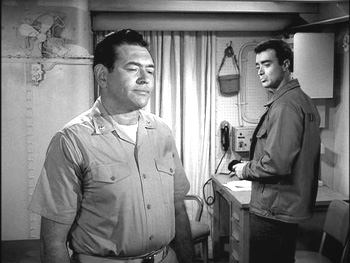
ORIGINALLY BROADCAST AS EPISODE 104
STARRING CAST: Mike Kellin, Simon Oakland, David Sheiner, John Considine
WRITER: Rod Serling
DIRECTOR: Perry Lafferty
SUMMARY: Hearing a knocking sound on his ship's sonar in the South Pacific, Chief Bell comes to the conclusion that his dead seamates are trying to call him home after their submarine was sunk in August, 1942.
RATING: V
This uncommon seafaring episode features a competent cast of familiar-faced character actors from the sixties (Forrest Compton, Bill Bixby, Simon Oakland, John Considine) and starring Mike Kellin as Chief Bell. Although the majority of the kudos go to Kellin for a bravura performance, "The Thirty Fathom Grave" takes too long to conclude. Had it been done as a half-hour episode, it may have been on a par with some of the best. Interestingly, this episode bears a vague similarity to "The Last Flight", in that the main character's conscience prods him to return to his rightful place in the great beyond. But intensity and suspense of its predecessor are lacking, making it more like a short TV movie or educational filmstrip about a man and his conscience than an episode of television.
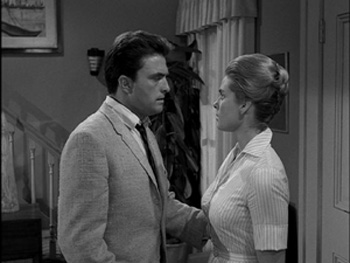
ORIGINALLY BROADCAST AS EPISODE 105
STARRING CAST: Ed Nelson, Natalie Trundy, David Opatoshu, Dabbs Greer, Jacques Aubuchon
WRITER: Charles Beaumont
DIRECTOR: Perry Lafferty
SUMMARY: Philip Redfield, a journalist on assignment, travels to New Mexico by car. Out of gas, he stops in a town called Peaceful Valley where everyone treats him very oddly. Fearing that he'll tell others about the place, they do not allow him to leave.
RATING: IV
This was one of the more intriguing episodes of the fourth season and one of the series' most scientifically sound. It starred Ed Nelson and David Opatoshu, with an appearance by Natalie Trundy (a fine talent whose career unfortunately plummeted in the mid-1970s after appearing in several of the "Planet of the Apes" sequels.) In this odd little town of Peaceful Valley, people and objects are manipulated with atomic disassembly/reassembly devices and every day items are not bought in stores - they are trivialized as loose collections of atoms assembled by a machine from a punchcard code.
This was not one of Charles Beaumont's better efforts, however. By this time, the thirty-four year old writer was suffering a rapid decline as a result of early Alzheimer's disease. By the end of the fourth season, he had all but stopped writing.
The characterizations are competent but rather cold-blooded and academic on the whole. Peaceful Valley looks more like a dingy, small town, which in fact was made up of sets used in many previous episodes of "Twilight Zone." For such an extraordinary place whose government prides itself on its seclusion and secrecy, it's appearance is curiously drab and almost resembles the old west. The place supposedly has a population of nearly a thousand residents but not more than a handful are seen. The so-called Sacred Equations that are supposed to end world hunger and poverty are kept a secret, but they turn out to be a hoax. If such a set of equations did exist somewhere, to keep them bottled up is pointless and goes against scientific norms. Further, the town officials tell Redfield that because he's entered Peaceful Valley he won't ever be permitted to leave for fear that he might tell others about their community, but at some point they brush this off, change their minds and decide they don't want him there anymore and that he must go. Inconsequential too is the romance between Philip Redfield and Ellen Marshall; they fall for each other and she finally agrees to leave with him, only to transport Philip back to the authorities with her atomic device after he rips off the phony blank book of equations from the vault. But despite even this, it turns out that Redfield did nothing more than stop at their gas station for gas and suffered a bad case of daydream.
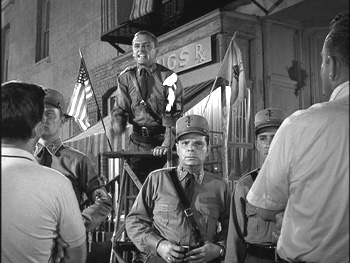
ORIGINALLY BROADCAST AS EPISODE 106
STARRING CAST: Dennis Hopper, Ludwig Donath, Curt Conway, Paul Mazursky
WRITER: Rod Serling
DIRECTOR: Stuart Rosenberg
SUMMARY: Peter Vollmer, a corrupted political rabblerouser, meets the ghost of Hitler after a series of ugly demonstrations.
RATING: V
Dennis Hopper stars as neo-Nazi Peter Vollmer in this Serling tale of hatred and society's keeping the evil flames of the past lit. This poor young lad, aged 20 something, fell victim to a world of hatred and neglect, thus making him into a cold-blooded, depraved soul who thrives on political demonstrations and making sure the whole world knows of his beliefs. At the advice of his allies, Vollmer kills Ernst, who had given him a home years ago when his own parents were viciously fighting. It is up to the viewer to decide whether or not the illusion of Adolf Hitler is sensical or not, or whether the commentary of the long-winded preachings of Vollmer are completely necessary. He gets shot and killed himself, thus making it all a bit pointless. In any case, Vollmer doesn't change his ways, and deals with rather controversial topics that are best left to the other Peter Vollmers of the world, not "The Twilight Zone". An interesting side note - Howard Caine, who played Nick Bloss, went on to play Major Wolfgang Hochstetter on another Nazi show called "Hogan's Heroes." The name 'Bloss' was a nod to John Bloss, an Assistant Director on the show. The name was also used in "Death Ship"; the note read by Lt. Carter to his wife and child, announcing his death, is signed "J. Bloss, Space Exploration."
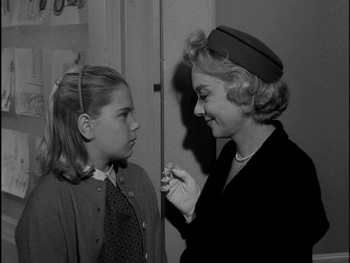
ORIGINALLY BROADCAST AS EPISODE 107
STARRING CAST: Ann Jillian, Frank Overton, Barbara Baxley, Irene Dailey, Oscar Beregi
WRITER: Richard Matheson
DIRECTOR: Stuart Rosenberg
SUMMARY: Ilse Nielsen has been raised to communicate only telepathically. Her parents die in a house fire when she is twelve years old, leaving her trapped in the world with no way to communicate. She is adopted by the local sheriff and his wife, who put her in school while they attempt to find her relatives. She does learn to talk, at the hands of an insensitive, rigid school marm.
RATING: III
"Mute" is one of four or five controversial episodes of the series. Richard Matheson's short story of the same title (the only real difference being that the main character is a boy named Paal) was certainly unusual enough for a "Twilight Zone" adaptation, but the production of the television episode and the casting have been debated for many years.
Ilse Nielsen is the victim of a dual tragedy. She is left rootless in the world, not knowing how to fend for herself at all, and she falls into the hands of some rather undesirable individuals. Mrs. Wheeler, wife of the sheriff of German Corners, Pennsylvania, is a conniving hysteric whose main concern in life is her own happiness. No doubt she will be a merely adequate foster mother, having already been a parent before her biological daughter died, but it is abundantly clear that she sees Ilse as no more than a figure which fate has given back to her as a replacement for what was lost. Worst of all is the ramrod-postured Miss Frank, a bitchy school marm who is intent on making Ilse "exactly like everybody else." She promises to guide Ilse into learning how to communicate, but the way in which it is done is a far cry from acceptable. She conducts the class as if it were a juvenile reform school, with clenched teeth and yardsticks. While clutching Ilse's cheeks in attempt to get her to 'shape up and quit pretending she doesn't understand', Miss Frank lets her know that her own father tried to do the same thing to her - he tried to train her to be a "medium", but she overcame the process and will supposedly help Ilse to do the same. Whether or not the house fire was, as Miss Frank says, "the blessing of her life" is a debatable point. She could have lived an acceptable life in either situation. It is up to the viewer to decide which is the better.
Cast in the lead was a very young Ann Jillian, long before she hit Broadway with Mickey Rooney in "Sugar Babies" and before she played Mae West on TV. She succeeds with a difficult part and gives a depth to Ilse that very few other child actors could have. All but the final scene consisted only of her facial expressions coupled with voice-overs. Frank Overton, who had played the father in "Walking Distance" during the first season and since then made a notable appearance as Heck Tate in To Kill a Mockingbird, was cast as Sheriff Wheeler. Barbara Baxley, who had roles in several (now obscure) Rod Serling films and Playhouse 90's, played his wife, Cora. Although they are not the most likeable couple in the world, they impart a unique individuality to the characters. Cora is every bit a neurotic, problemated housewife. Oscar Beregi, who had much spicier roles in "The Rip Van Winkle Caper" and "Death's Head Revisited", appears as one of the project participants. He and his wife venture to American shores to claim Ilse, but the original contract of the telepathy project somehow left out provisions for the subject's care in the event of parental demise. Apparently Ilse has no relatives anywhere in the world. The part of Miss Edna Frank was given over to Irene Dailey, who breathed life into the icewater battleaxe. Dailey said of the part, "It was my second role in Hollywood - I was always based in New York in the theater but they always flew us out for the juicy [TV] roles. Stuart Rosenberg later directed me in the first "Amityville Horror" film. Working with him was always a joy."
Bill Erwin, a prolific character actor whose career lasted over seven decades, appeared ever so briefly as the man at the door in the flashback sequence who brings the dead Wheeler daughter back home after drowning in the lake, said, “I’d completely forgotten about it – and for the longest time, I thought I was credited with doing three of them but now it’s four, and I only remember two! I met Mr. Matheson a few times, but it was not connected to “Twilight Zone.” As most of my fans know, I played Arthur, the bellman, in his “Somewhere In Time”, many years later.”
The thesis of "Mute" is not so objectionable. It's a fairly realistic, albeit odd, situation. But it seems to take many wrong turns and thus leaves the impression that the same or better an outcome for the protagonist could have been achieved, had things been handled differently.
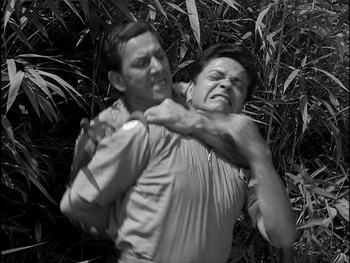
ORIGINALLY BROADCAST AS EPISODE 108
STARRING CAST: Jack Klugman, Ross Martin, Frederick Beir
WRITER: Richard Matheson
DIRECTOR: Don Medford
SUMMARY: Lieutenants Paul Ross, Ted Mason, and Mike Carter have been given orders to pick up specimens from other planets. Thinking he sees something interesting on the monitor as they fly over part of an unchartered planet, Mason suggests they land. They do, and find a crashed spaceship with THEIR dead bodies inside it. Ross is convinced that the bodies are not theirs...that they are alive and it's all an illusion.
RATING: I
Richard Matheson's disquieting, tension-packed and often violent script (based on his short story of the same title) is a masterwork about human will and need for control, and man's longing for love. A combination of themes that only "Twilight Zone" could explore so successfully, and without this entry, it would be far less complete.
Martin (Lt. Mason) and Klugman (Capt. Ross, the mission leader) generate most of the static, most audible when Ross breaks up the serene reuniting of Mason and his (dead) wife and daughter who were killed in an automobile accident. The two actors, in character, exchange a considerable amount of eye contact, under which lies an ocean of resentment. Frederick Beir (Lt. Carter) is not the pacifist of the group, nor does he try to be. He clearly has the same hatred for Ross, if not more, but it isn't as prominently displayed. When he arrives home, on the long road to his house, he barely hears the voice of his friend (played by Ross Elliott), focused solely on the passion for the companionship of his wife that runs long and deep inside him.
Despite the technical limitations of the day, "Twilight Zone" could always be counted on for convincing photography in place of special effects. The landing and take-off of spaceship E-89 is always impressive, as is the sequence in the first act where the crew inspects the 'other' crashed spaceship has the unforgettable few minutes wherein they find their dead selves. The film editing is remarkably good and presents what is supposed to be a horrific illusion. The music heard throughout is a remarkably well-scored mixture of extracts from scores written for earlier episodes. Jerry Goldsmith's "Back There", Fred Steiner's "King Nine Will Not Return".
Directing "Death Ship" was Don Medford, who had so competently dealt with such despondence in "Death's Head Revisited." He had at his disposal considerable talent in the leading cast, and was able to breathe even greater fire into the already energetic principals. He also had fine support in Mary Webster (last seen with Klugman in "A Passage for Trumpet", which he also directed) and Ross Elliott as Kramer, who died in a hunting accident and appears in Carter's trip home - the first evidence that the three are in fact dead. A girl named Tammy Marihugh submits a remarkable sixty seconds of screen time as Mason's daughter.
Despite the virtuosity of his performance in the lead, Jack Klugman is no fan of "Death Ship." "I loved the other episodes I did, but I didn't like that one much," he said over forty years after the fact.
Fine acting and emotional fireworks aside, "Death Ship" makes the important assertion that there are people who can not and will not accept things that are beyond their power to accept.
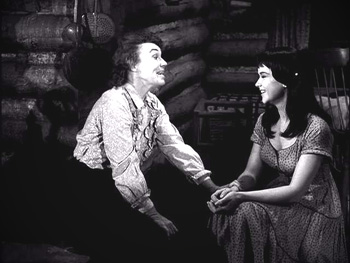
ORIGINALLY BROADCAST AS EPISODE 109
STARRING CAST: James Best, Anne Francis, Laura Devon, Jeanette Nolan
WRITER: Earl Hamner, Jr.
DIRECTOR: Buzz Kulik
SUMMARY: Jess-Belle wants to win the love of Billy-Ben Turner, but the only way she can do it is if she has the aid of a magic potion that will make her into a witch!
RATING: II
Earl Hamner's largest contribution to "The Twilight Zone" came with "Jess-Belle". In "The Hunt", he had merely showed his competence and his ability to construct a fantasy story that combined elements of the backwoods, but "Jess-Belle" really and truly explores the territory Hamner was most familiar with.
In the marvelous tale, which might have even been better titled "Bewitched", the forces of three actors - Anne Francis, James Best, and Jeanette Nolan, who had made strong impressions in earlier episodes, combined to make what is one of the finest of the hour episodes. With Laura Devon, Virginia Gregg, and George Mitchell, the actors make the material shine brightly. Best remarked recently, "The writing was so good in those days...these days, if you're over 30 years old, you're not on the cutting edge anymore. I'm glad I'm dull!" The first act boasts a beautifully-written scene with Jess-Belle and Billy Ben under a tree, which Best and Francis both have fond memories of. Anne Francis says, "Jimmie was a good kisser, as I recall... I remember the scene we did under the tree. That was just great! Of course, we were only romantic on screen."
Although there isn't a weak performance to be found, it is Nolan's Granny Hart that serves as the show's backbone. She is a cauldron-stirring sorceress, brimming with subtleties, who takes great pleasure in her life as a witch. "Jess-Belle" is almost like a play, much unlike any of the other hour shows. It is a bonafide homespun tale, complete with song that bridges each segment with a folk song: "Fair was Elly Glover, dark was Jess-Belle, both they loved the same man, and both they loved him well."
The dramatic sequence between Jess-Belle and her mother (Virginia Gregg), when she accidentally mentions Granny Hart and the secret that she's been witched, then instructs her mother to not open the door to her bedroom until the next morning is also fine Hamner storytelling. Jess-Belle's witchdom does create some flying sparks, particularly at the end. After all, it takes more than a rifle to kill a witch. A huge rat climbs on a clock which narrowly misses Elly as it smashes to the floor. But it is the silver hairpin - which Jess-Belle had originally given to Granny Hart in payment for the spell - that is needed to end the unruly Jess so that Billy Ben and Elly can begin their life together.
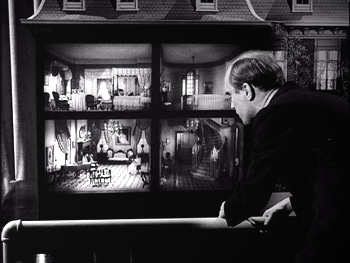
ORIGINALLY BROADCAST AS EPISODE 110
STARRING CAST: Robert Duvall, Barbara Barrie, Pert Kelton, Lennie Weinrib
WRITER: Charles Beaumont
DIRECTOR: Walter E. Grauman
SUMMARY: Charley Parkes is a thirty-something office worker who doesn't fit in with the rest of the world...and finds an escape.
RATING: I
One of Robert Duvall's first acting jobs was in one of the last stories Charles Beaumont would ever write. At the time, Duvall was very new to the biz. He was not a child prodigy, having begun his career in his early thirties. He would eventually become a fixture on the wide screen, of course, but not before doing some fine episodes of television. Opposite Duvall in "Miniature" were Pert Kelton (the first Alice Kramden of "The Honeymooners", plus a wealth of other stage acting credits) and Barbara Barrie (best remembered for her role as the mother on "Breaking Away" and as Nana on "Suddenly Susan" with Brooke Shields). It is hard to single out the most striking of the three performances; all are superlative. Duvall with just the right touch of virginal mousiness as 30-something Charley Parkes, Kelton as the doting mother who never let him grow up, and as his sister (who did break away from their mother and married) Barrie plays the concerned family member who tries to help Charley get onto a normal life track. The best, and most moving part of the story is a discussion they have in a restaurant. Myra has followed Charley into a museum, pretending that she just happened to run into him. She confesses that it wasn't accidental...and that she's on to his wanting to retreat there so he doesn't have to face life. To no avail, she fixes him up with a friend of hers, which only leads to more reclusiveness. Charley eventually gets what he wants, to fully escape from a world which obviously wants not for his presence.
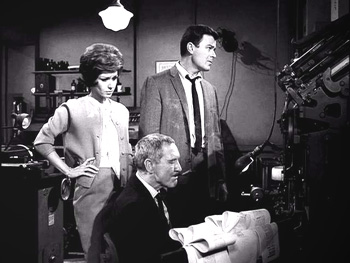
ORIGINALLY BROADCAST AS EPISODE 111
STARRING CAST: Burgess Meredith, Robert Sterling, Patricia Crowley, Camille Franklin
WRITER: Charles Beaumont
DIRECTOR: Ralph Senensky
SUMMARY: Mr. Smith, a linotypist and news reporter, arrives in Danzburg one evening in search of employment. Unfortunately, the Danzburg Courier is about to go bankrupt after the bigger and richer Danzburg Gazette moves into town and wipes them out. Smith offers to temporarily waive salary and give them a loan of $5,000. This all sounds good, until Smith is proven guilty of causing catastrophes in order to generate scoops for the paper before the Gazette can get to them!
RATING: II
In "Twilight Zone"'s first season, Thomas Gomez played Cadwallader in "Escape Clause". In season two, Robin Hughes played The Howling Man. Burgess Meredith's last of four "Twilight Zone" appearances was in this delightful story by Charles Beaumont about Douglas Winter (played by Robert Sterling), editor of The Danzburg Courier, and his encounter with The Devil personified. Whereas the earlier two installments barely explored the Devil and all his connivery, "Printer's Devil" takes the subject matter very seriously; there are some laughs to be had, but it is not a story of tomfoolery. The writing seems especially oriented toward Meredith, and he does splendidly in the role. Like Jack Carson in "The Whole Truth", Meredith clearly enjoyed the part, and the director obviously gave him the freedom to overact to the hilt (a "crime" the actor was often charged with by critics). But his performance is one to savor, as it's one of his best. The men he'd played earlier were more or less bland losers, doomed from the onset, with no hope of recovery. Mr. Smith, the witty Devil with a crooked cigar, is determined to nab Winter's soul, provided he doesn't get ousted by his own trickery. A classic moment comes when Mr. Smith's glowing "E.T."-style finger used to light the cigar. Horrified, Winter looks on as Smith 'strikes it up'...but he's too irate to make comment on it. Seconds later, he's fires half a barrel at Smith. "That leaves you three," Smith barks back at him.
Camille Franklin, who had a small part as Molly, the waitress who serves Sterling and Meredith, relates, "Ralph Senensky knew Sandy (Sanford) Meissner very well - I was in Sandy's acting class, and I'm sure that's how he found me, and cast me in it. The part wasn't big but it was great - I remember we re-shot my close-ups once or twice. You couldn't ask for much more, acting alongside such great talents as Burgess Meredith and Bob Sterling."
But this is not to say that the episode is flawless. Patricia Crowley seems to have her share of challenges with the part of Jackie Benson, Doug Winter's love interest. Throughought, she seems overly frustrated. Additionally, there are perhaps two too many catastrophes caused by Mr. Smith before it is fully realized that he was the perpetrator; these 'extra' segments merely serve as time-fillers and the stock footage used is not always convincing. But despite these insignificant problems, "Printer's Devil" was one of Beaumont's best stories. The original short story was one of the first he ever wrote and the villain was named Tomerlin, not Smith (after his good friend, writer John Tomerlin).
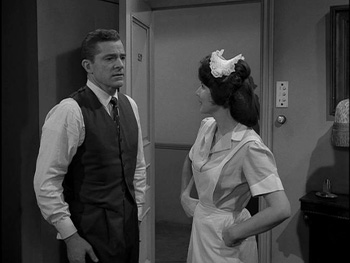
ORIGINALLY BROADCAST AS EPISODE 112
STARRING CAST: Dana Andrews, Robert F. Simon, Patricia Breslin, Marjorie Bennett, Robert Cornthwaite
WRITER: Rod Serling
DIRECTOR: Justus Addiss
SUMMARY: Physicist Paul Driscoll travels backwards in time to change the past in order to make the future better.
RATING: V
Underrated and now largely forgotten actor Dana Andrews is Paul Driscoll, a physicist who visits four ports of call in attempt to alter the past. With the aid of his friend Harvey (Robert F. Simon) and a time machine, he returns to Hiroshima the day it was bombed in 1945, to Germany during the Hitler era, and to the day the Lusitania ship was torpedoed in 1907. He's unsuccessful in Hiroshima and on the Lusitania - the authorities won't listen to him and take him into custody. In Germany, the chambermaid of the hotel finds him offensive and summons the police just as he gets Hitler in the crosshairs of his rifle. Luckily, he narrowly escapes all three situations. He then chooses to settle in Homeville, Indiana of 1881 for a time, in attempt to stop a schoolhouse fire and save the lives of some children, and perhaps even stop the assassination of Garfield. He takes interest in Ms. Abigail Sloan (Patricia Breslin), the town schoolteacher. But in his attempt to change things, he ends up causing the school to burn down. He returns to the present, convinced that the past is inviable and that he'd be better off doing something about the tomorrows.
Like "Back There", "No Time Like the Past" begins with a wooden-sounding, Ivy-league style theoretical discussion between two colleagues about the possibility of altering the past. This time, the argument is centered around how we live in a society run by "scientifically advanced monkeys" who are thrusting us into a "cesspool, with bombs, explosions, and fallout." Surprisingly, physicist Driscoll does not have the sense to realize that he has no power to change the past. And even if he could, chances are mighty slim that he'd be able to improve things with any degree of significance such as poverty or prevention of war. Swiftly time-traveling back to the first three ports of call, Driscoll meets the same failure. But in point of fact, he has the golden opportunity to assassinate Hitler but doesn't seize the moment. Even if he had, however, we all know that Hitler's death was not at the hands of any civilian. The most extensively-explored of the four segments is the final one in Homeville, where Driscoll could conceivably change the course of events and prevent a smaller-scale accident. During his stay there, President Garfield is shot and to the shock of Ms. Sloan, Driscoll already knows the outcome of this too...that Garfield won't recover. He meets a few disbelieving townspeople such as Hanford (Robert Cornthwaite), a resident at the local boarding house. Driscoll asserts loudly at the dining room table that he's sick and tired of old and patriotic men like Hanford preaching about the notion that the United States grows stronger in direct proportion to the filling of its graveyards with young soldiers (the best two minutes of the hour). However, Hanford is a mild case compared to the loony Professor Eliot (Malcolm Atterbury, who had an identical although less spicy role as Henry J. Fate in "Mr. Denton on Doomsday") as a health tonic salesman. With lantern-lit wagon parked just across from the schoolhouse, Driscoll somehow gets the notion that Eliot's horses will take off in a frenzy and cause the lantern to start the fire. Just before he leaves for good, Driscoll riles Eilot to the point where the horses go wild and do just that.
Like many other episodes, "No Time Like the Past" is Serling through and through, commenting on social issues through the gimmick of time travel. In this case, though, it doesn't work. Had Serling focused on just one return to the past, to Homeville, and as a half-hour episode, "No Time Like the Past" may have succeeded as a time-travel story. Instead, it emerges much as "Back There" did...Peter Corrigan changed the future, but not for the better and not as he'd intended. Paul Driscoll didn't change the past in attempt to improve the future...he caused the past, and not for the better.
Trivia: This was the most expensive episode ever produced in TZ's five year run. The cheapest episodes, which came in earlier seasons, rang in at around $40,000. "No Time Like the Past" had a ledger balance of approximately $160,000.00, which at that time was staggeringly high. This is surprising, as "No Time" has very simple sets and no special effects. But hey, that's Hollywood - going over budget, often by millions of dollars, is just everyday faire.
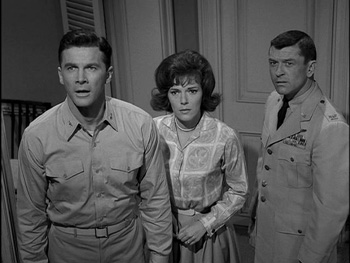
ORIGINALLY BROADCAST AS EPISODE 113
STARRING CAST: Steve Forrest, Jacqueline Scott, Frank Aletter, Philip Abbott, Shari Lee Bernath
WRITER: Rod Serling
DIRECTOR: Alan Crosland
SUMMARY: Major Robert Gaines goes on a space mission and comes back to a parallel world where he's not who he thinks he is and where certain historical events have different outcomes, including the fact that the president at the time is not John F. Kennedy.
RATING: IV
The only siblings to star on "Twilight Zone" were Dana Andrews and Steve Forrest (15 years his junior), and the two episodes they appeared in were originally aired back to back.
As he had done so successfully in "Mirror Image", Serling once again explored the notion of parallel worlds. Starring Forrest (Academy Award nominee for his performance as Lt. Harrelson on "S.W.A.T." in 1975) and Jacqueline Scott ("Firecreek", "Death of a Gunfighter", "Duel", "Empire of the Ants", and a host of theater credits), this is one of the most thought-provoking of "Twilight Zone"'s, and benefits greatly from fine staging and incorporation of space stock footage. Where it almost completely falls down is in the way the actors play down the roles to the point of maudlinity. As Major/Colonel Robert Gaines, Forrest is a soft-spoken, 'nice' person who lacks much-needed energy. Scott is fine as his similarly soft-spoken wife, as are Frank Aletter and Philip Abbott as the chief lieutenants, but it's obvious that the director's approach did not stress urgency or quick-paced dramatic progression. Further, several headshakers make things mighty difficult to follow, such as the notion of a world where John Kennedy is not President of the United States and a whole list of major historical events that Gaines reads off that had different outcomes. The radio communication from another Col. Robert Gaines comes in to NASA after Gaines (already having returned from the mission) is seen running toward the spacecraft is indeed spooky, but concludes things on a bland note when nothing ever comes of this.
As has been mentioned elsewhere, "The Parallel" bears some similarity to the compelling 1969 film "Journey to the Dark Side of the Sun", written and directed by Gerry and Sylvia Anderson, starring Roy Thinnes. Unfortunately, this film never hit the top of the charts either.
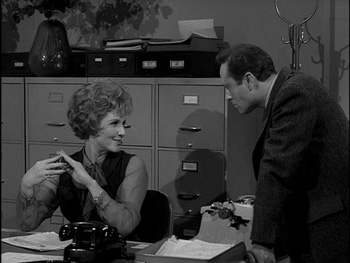
ORIGINALLY BROADCAST AS EPISODE 114
STARRING CAST: Howard Morris, Patricia Barry, James Milhollin, Loring Smith, Jack Albertson
WRITER: John Furia, Jr.
DIRECTOR: Robert Gist
SUMMARY: George P. Hanley, who leads a hum-drum life as an office worker, picks up a genie lamp at a curio shop and after some turbulent trials, becomes a genie.
RATING: IV
John Furia, Jr.'s single "Twilight Zone" script was the comedy "I Dream of Genie." Starring veteran comedy actor and director Howard Morris (best known for his unforgettable portrayal of Ernest T. Bass on "The Andy Griffith Show", which he was playing semi-regularly around the same time), and Patricia Barry, it has some entertaining moments but ultimately goes nowhere. The character George P. Hanley is much like Serling's dullard Mr. Bevis; he has lived a life of failure where everyone walks all over him. Throughout, Morris is quite obviously uninspired, reciting almost every line blandly. As the pretty secretary-turned-movie star, Barry doesn't do much better than she did in "The Chaser" as Leila. Oddly, here too the man who has the hots for her is named Roger (Roger Shackleforth was her "lover-boy"'s role in "The Chaser"). Similar to "No Time Like the Past", the main character visits four different tableauxes. But each is more corny than the next and even though this is a comedy, it lacks any real dramatic climax. Tying each of the discrete threads together is use of a slobbering terrier dog as a progressive plot element. Ultimately, Hanley does prevail and becomes a genie, which was supposed to give the impression that he's moved up in the world and escaped the hum-drum life. But this too serves as yet another plot device, a pale wrap up to a rather pale series of events.
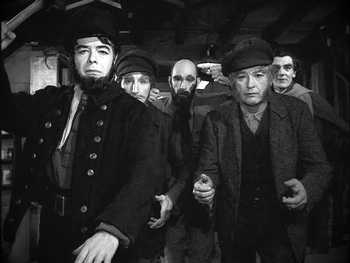
ORIGINALLY BROADCAST AS EPISODE 115
STARRING CAST: Martin Balsam, Will Kuluva, Maggie Mahoney, William Mims
WRITER: Jerry Sohl
DIRECTOR: John Brahm
SUMMARY: When Ferguson's Wax Museum closes up shop, Martin Senescu (curator of the Murderer's Row exhibit) offers to take the figures of legendary murderers into his own care...but they start behaving rather oddly.
RATING: IV
Jerry Sohl's "The New Exhibit" was the first of three episodes he scripted that focused on gruesome demises. It was directed well by John Brahm, but should have gotten higher marks in certain areas. Martin Balsam, who himself had been knifed to death three years earlier in "Psycho" (as detective Milton Arbogast) was not the best choice for the lead here. Except for the five minute teaser, wherein Senescu gives his spooky Murderer's Row tour, it sounds like he's reading all his lines off a cue card. Balsam was a fine dramatic actor but he has great difficulty playing the part of 'good guy-turned-bad guy' here. The role itself was an awkward one; Senescu is supposed to be kind and gentle (although Sohl appropriately named him - 'senes' is the Latin root for "wicked"!) But he's worked with the figures for so long that he's fallen into mental illness over them. It turns out that the figures have much more power than Senescu ever gave them, however. This is a clever fantasy, but it was clearly not Senescu who murdered Emma, Dave, and Mr. Ferguson. Insisting that this was the case, they descend upon Senescu and murder him, only to have his image eventually end up in a European historical museum. This is a tremendously weak conclusion.
"The New Exhibit" makes use of what are supposed to be inanimate people. It didn't work in "Elegy", barely worked in "Still Valley" and it doesn't work well here. The people hired as the figures were made up well to resemble the historic murderers of the past (Jack the Ripper, Burke and Hare, et al) but the viewer can't help but get the impression that they are no more than actors in makeup. But for all these shortcomings, the scene where Dave (William Mims) goes down to the basement and finds wet cement (under which lies his sister, whom he will soon join) makes the whole episode worthwhile. Mims suddenly looks up at the wax ax murderer, and his life is gone a split-second later. This is a heart-stopping moment - perhaps the scariest in the entire "Twilight Zone" anthology.
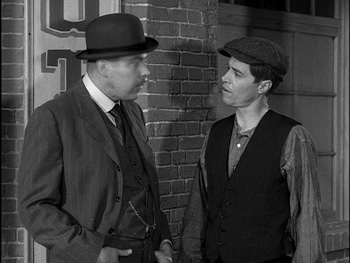
ORIGINALLY BROADCAST AS EPISODE 116
STARRING CAST: Albert Salmi, John Anderson, Wright King, Julie Newmar, Guy Raymond
WRITER: Rod Serling, based on the short story "Blind Alley" by Malcolm Jameson
DIRECTOR: David Lowell Rich
SUMMARY: Wealthy business tycoon William Feathersmith is bored with life and makes arrangements to go back to Cliffordville of the 1930's, where he can start from the ground all over again. He does, but this time makes some rotten investments and ends up far worse off than he had originally been.
RATING: V
"Of Late I Think of Cliffordville" was an adaptation of the intriguing short story "Blind Alley" by Malcolm Jameson. It isn't without interest, but at an hour, it is painfully long and much of the material seems to be thrown in to kill time. One glaringly bad addition was a segment with the family of a wealthy Cliffordville banker wherein his awesomely untalented daughter plays the piano and sings. In the leads, Albert Salmi, Wright King, John Anderson, and Julie Newmar are fine but the fantasy is just too tongue-in-cheek. Feathersmith, once wealthy, returns to the present as the custodian of the building he used to own; this is mighty hard to swallow. The makeup jobs on the actors were embarrassingly bad (with the exception of Newmar, a natural beauty) and the sets for what is supposed to be Cliffordville of years ago are stereotypical and uninteresting.
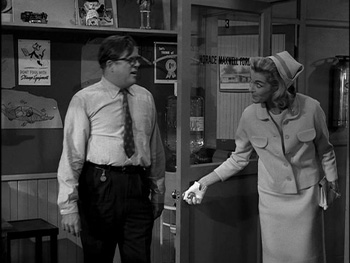
ORIGINALLY BROADCAST AS EPISODE 117
STARRING CAST: Pat Hingle, Nan Martin, Ruth White, Phillip Pine, Vaughn Taylor
WRITER: Reginald Rose
DIRECTOR: Abner Biberman
SUMMARY: Horace Ford is preoccupied with his childhood...he longs to return to a time that passed him by all too quickly. His wife and mother can't stand to watch him go through this and it so interferes with his livelihood that he gets fired from his job as a toy designer. Eventually, he comes full circle and realizes that his childhood is not worth going back to, that it was all a bad nightmare.
RATING: II
This episode explores the rather curious idea that someone can look back on childhood years as being a time of great joy, then suddenly come to the realization that it was really all a bad nightmare. For most, life is just the opposite, but Reginald Rose's story lays out the idea quite well. It was originally broadcast on "Studio One" in 1955 with Art Carney starring as Horace. Today, Pat Hingle still vividly recalls the original version.
In the lead, veteran character actor Pat Hingle is fantastic, as is Nan Martin. This was not the first or last time Hingle and Martin played opposite each other. They appeared together in the Broadway play "J.B." and later in "The Fugitive". As Horace's mother, Ruth White too is perfect. A year earlier, White had been cast in what was to be a significant part as Miss Dubose in "To Kill a Mockingbird", which was cut down to a 30-second part. Here she plays the doting widow mother, complete with with grating voice and obsessive, slightly hysterical personality. Vaughn Taylor could always be counted on for a great performance, and he doesn't disappoint as Judson, who puts up with Horace as long as he possibly, and professionally, can before dismissing him.
Like most of the hour episodes this is simply too padded. By the time Horace visits Randolph Street for the third and final time, the dramatic bite has dissipated. There is also a lack of chemistry between Horace and Laura. He's geeky and she's a knockout. Rose constructed most of the intermediate scenes - Horace's visits to Randolph Street, followed by Hermy Brandt's brief appearances at the adult Horace's home - very well, and the conclusion is quite touching. The streets are dark and deserted as Laura finds Horace the child, lying unconscious and injured in the street. He returns to his adult self and goes forward, having left behind his temporary illness. The episode closes fitfully, as Hermy Brandt's figure appears atop a lamppost, as a sort of reminder to us that one's history is indestructible...there will always be kids around to remind the adults of the world of their younger years.
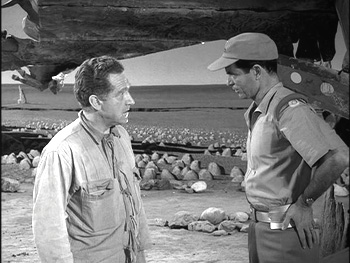
ORIGINALLY BROADCAST AS EPISODE 118
STARRING CAST: James Whitmore, James Broderick, Tim O'Conner, Jo Helton, Daniel Kulick
WRITER: Rod Serling
DIRECTOR: Buzz Kulik
SUMMARY: After thirty-some-odd years of life on an asteroid, a ship finally arrives to pick up the residents of the colony and take them back to Earth. The colony leader, William Benteen, wants them to stay together once they return to Earth but the colonists want no part of this plan.
RATING: III
James Whitmore's Captain William Benteen - although no relation to the famed historical figure of the same name, the name invokes the same power - was the subject of the last of the 60-minute episodes produced. A larger-than-life figure was needed for the role. Whitmore, thespian extraordinaire, was an obvious choice. Most of the younger generation know the actor for his incredible 1994 performance in "Shawshank Redemption" (after he was in semi-retirement), but Whitmore started working in the biz around 1950, eventually landing the lead in the superb-yet-short lived TV series "The Law and Mr. Jones".
Benteen is one of Serling's finest characters, and one of the most complex. He undergoes quite a metamorphosis...from Godlike leader to lone lifeform on an asteroid. He is a fine storyteller and a seemingly rational human being, who has successfully led a group of people for twenty years or more. But when it looks like his powers are going to be dissolved for good, his true blood comes out as a hypnotic, bullheaded tyrant. Earth officials move in and immediately supplant his authority, ways and means, right down to the way to cure broken arms after sporadic meteor storms. Despite Benteen's warnings to the colony that Earth is a miserable place, filled with war and hate, they want no part of his plan to stay together once they return. Benteen holds out until the last minute hoping things will change. At some point he has a change of heart, but wakes up a minute too late on the morning the ship departs.
An interesting aside- the large segment in the second act wherein Col. Forbes (Tim O'Conner) answers questions about what life is like on Earth. Someone asks about schools, and Forbes mentions that students are able to watch live video presentations of things they are learning about, such as The Grand Canyon. That such an anachronism was written into the script was proof that Serling envisioned newer and more useful forms of relaying information and having that information be easily accessible. Sound familiar? It should.
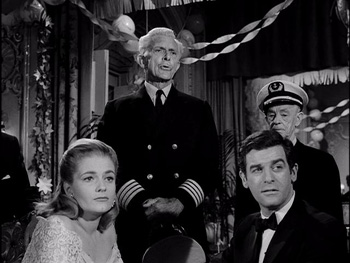
ORIGINALLY BROADCAST AS EPISODE 119
STARRING CAST: Lee Philips, Joyce Van Patten, Gladys Cooper, Wilfrid Hyde-White, Cecil Kellaway, Cyril Delevanti
WRITER: Charles Beaumont
DIRECTOR: Lamont Johnson
SUMMARY: Alan and Eileen Ransome have been married for six years but are only now taking their honeymoon...for the purpose of saving their marriage.
RATING: IV
Lee Philips and Joyce Van Patten (of the long-time TV acting family of Van Pattens) join a large cast of over-75 actors for this delightful old Londonesque voyage across the ocean. While the focus is mainly on the sentimental, there is a gripping few minutes after the couple have a heated argument. Alan suspects Eileen has gone overboard. It turns out that the Ransome's being ordered to leave the ship is the most touching element of the story - as the group of folks from the yesteryear fade off into the landscape along with the ship that had played such an important part of their lives. And in turn, "the old tub" did its number on The Ransomes. As Millie McKenzie (Gladys Cooper, in fine form as usual) says, "I see the Lady Anne has worked her magic on you."
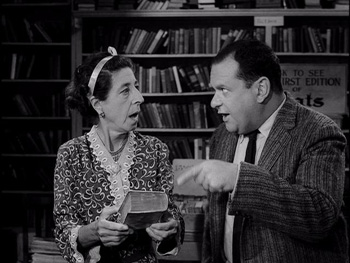
ORIGINALLY BROADCAST AS EPISODE 120
STARRING CAST: Jack Weston, Henry Lascoe, John Williams, Burt Reynolds, Marge Redmond, Judy Strangis
WRITER: Rod Serling
DIRECTOR: David Butler
SUMMARY: Julius Moomer, a former streetcar conductor and wanna-be writer, is determined to get his work made into a TV show. After many failed attempts, he finally gets the network writer's office to submit one of his scripts. He summons the likes of Shakespeare to come in and help him out.
RATING: III
Three years after "A Stop of Willoughby", which addressed television networks grinding down a middle-aged advertising exec, Serling returned to the theme in "The Bard", a delightful comedy about a man who longs to get into the biz. Streetcar conductor-wanna-be-writer Julius Moomer is the pestilence of the writers office. In the lead, Jack Weston is wonderful, and imbues the role with loads of fun and imagination. Alongside of him as a smarmy secretary is veteran charactor acterss and Weston's then-wife, Marge Redmond. John Williams' (no relation to the award-winning composer) characterization of Shakespeare never fails to please. Cora, a wise little girl who lives in the same apartment building was played by Judy Strangis, who later had a recurring role on "Room 222". "The Bard" also offers up one of the first TV appearances of an actor named Burt Reynolds, doing a genuinely "New Yawwwk" impression of Marlon Brando as a cast member in the new TV show developed by Moomer and Shakespeare. But when Shakespeare shows up at the rehearsal, young 'Brando' takes an instant dislike to him:
SHAKESPEARE: Jeremy is supposed to be a lad of nineteen.
RHODES: Yeah well, we changed all that. We decided that this guy has gotta be a guy with some zazz, a guy with some moxie. This is a guy who's gotta know the score. You ever hear of "Cat on a Hot Tin Roof?"
SHAKESPEARE: Cat....on a...hot...tin...roof? And what perchance would that be?
RHODES: That would be a play, Charlie. Jeez, it's gettin' so they let any uncultured, uncouth ham in here.
Jack Weston and Carol Burnett - both newcomers to Hollywood at the time they appeared on TZ, would later appear together in Alan Alda's film The Four Seasons Interestingly, their TZ scripts, both written by Rod Serling, featured a scene on a public transportation city bus. TZ was filmed at MGM in Culver City, and when called for, utilized the city buses of that neighborhood. "But this time, we got in trouble for it," said George T. Clemens. "Supposedly they never got paid for that day of shooting."
After four years of a series that had by now run a wide gamut and had undergone many transformations of its own over the course of 120 episodes, it wasn't clear as to where "Twilight Zone" was going next. To many involved directly with the show, it seemed like the series had run its course...and Serling was definitely one of those who felt that way. The best work had been done, many incredible stories had been produced. In some cases, "Twilight Zone" had done the impossible and touched on subjects never tackled before on TV. The show ended up going back to half an hour (23 minutes, with commercials) for the 1963-64 season, with a production lineup that included a staggering thirty-six more episodes. The final lot included a few of the best and many of the 'least', but nothing could detract from what had already been achieved previously. Other series' would try to pick up where Serling and his group left off. Although there have been many good attempts over the years, including Serling's "Night Gallery" seven years hence, none would ever achieve the magnetic resonance of "The Twilight Zone".
© 2002-2015 The Twilight Zone Museum. All Rights Reserved. Use of the material herein without written permission from the author is strictly prohibited. See website disclaimer for details.
